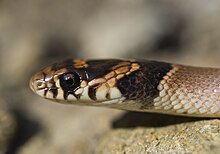Headband dwarf snake
| Headband dwarf snake | ||||||||||||
|---|---|---|---|---|---|---|---|---|---|---|---|---|

Headband dwarf snake ( Eirenis modestus ) |
||||||||||||
| Systematics | ||||||||||||
|
||||||||||||
| Scientific name | ||||||||||||
| Eirenis modestus | ||||||||||||
| ( Martin , 1838) |
The Eirenis Modestus ( Eirenis modestus ) is a snake of the family of snakes .
description
With a total length of 50 to 60 centimeters, this snake is a rather small adder, while it is one of the larger representatives of the genus of the dwarf snake . The males have a slightly longer tail than the females in relation to the length of their head and torso . Her head is barely set off from the neck and body, the muzzle bluntly rounded. The pupils are round, characteristic of snakes. The color of the top and sides is usually light brown, gray-brown or reddish-beige. The belly is yellow or whitish gray. There is a typical black mark on the head, which can, however, completely fade with age. This consists of five bands at the level of the nose, the eyes, the crown shields (see snake scale names ) and around the neck. The eye band is M-shaped, the crown band is crescent-shaped. It can therefore be easily distinguished from the closely related collared dwarf snake ( Eirenis collaris ), which only has a wide collar.
Around the middle of the body it has 17, very rarely 19 rows of back scales, while Eirenis collaris has only 15 rows of back scales. The scales are smooth. Males have 155–183 ventral scales and 62–81 scales on the underside of the tail ( scutum subcaudale ), while females have 170–191 ventral scales and 60–74 subcaudals.
Occurrence

The headband dwarf snake occurs in West Asia in Turkey , in the Caucasus region ( Georgia , Armenia , Azerbaijan , Dagestan ), in Syria , Iraq and Iran . In Europe it lives in the European part of Turkey and on some Aegean islands ( Lesbos , Chios , Samos , Alatonisi , Leros , Kalymnos and Symi ) and is one of the two European dwarf snakes next to Eirenis collaris . In the Terra typica , the city of Trabzon in northeastern Turkey, it has not been found again since it was first described.
Way of life

The headband dwarf snake prefers dry, rarely also slightly damp habitats, especially stony terrain with bushes or sparse forests. It has been proven up to an altitude of 1,800 meters. During the hot time of the day, it hides in caves in the earth, crevices in the rock or under hollow stones. It feeds primarily on insects , millipedes, and arachnids in the wild . In captivity, the food spectrum is more unspecific and limited mainly by the size of the prey.
In June to July, the headband dwarf snake lays 3–8 eggs, from which 10–12 cm large young hatch in September.
Subspecies
- Eirenis modestus modestus (MARTIN, 1838)
- Eirenis modestus semimaculatus (BÖTTGER, 1876)
- Eirenis modestus cilicius (SCHMIDTLER, 1993)
In southern Anatolia around Mersin , Eirenis modestus semimaculatus lives sympathetically with the closest related species Eirenis aurolineatus .
literature
- Josef F. Schmidtler and Ibrahim Baran: Eirenis modestus (Martin, 1838) - headband dwarf snake . In: Wolfgang Böhme (Hrsg.): Handbook of Reptiles and Amphibians in Europe - Volume 3 / I - Snakes (Serpentes) I - (Typhlopidae, Boidae, Colubridae 1: Colubrinae) . Aula Verlag, Wiesbaden 1993, ISBN 3-89104-003-2 , p. 279-292 .
- G. Diesner, J. Reichholf: Steinbachs Naturführer, Lurche und Kriechtiere , Mosaik Verlag, 1996, Munich, ISBN 3-576-10697-9
Individual evidence
- ↑ ZT Nagy, JF Schmidtler, U. Joger, M. Wink: Systematics of dwarf snakes (Reptilia: Colubridae: Eirenis) and related groups on the basis of DNA sequences and morphological data . In: Salamandra . tape 39 . Rheinbach 2003, p. 149-168 .
Web links
- Eirenis modestus in The Reptile Database
- Image of a juvenile headband dwarf snake with typical drawing
- Eirenis modestus inthe IUCN Red List of Threatened Species 2013.2. Posted by: Petros Lymberakis, Varol Tok, Ismail H. Ugurtas, Murat Sevinç, Pierre-André Crochet, Göran Nilson, Steven Anderson, Claus Andrén, 2009. Retrieved January 5, 2014.